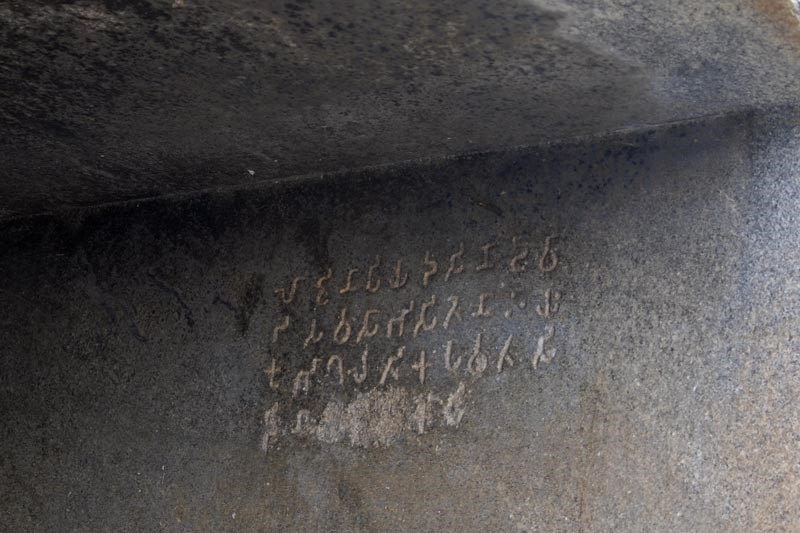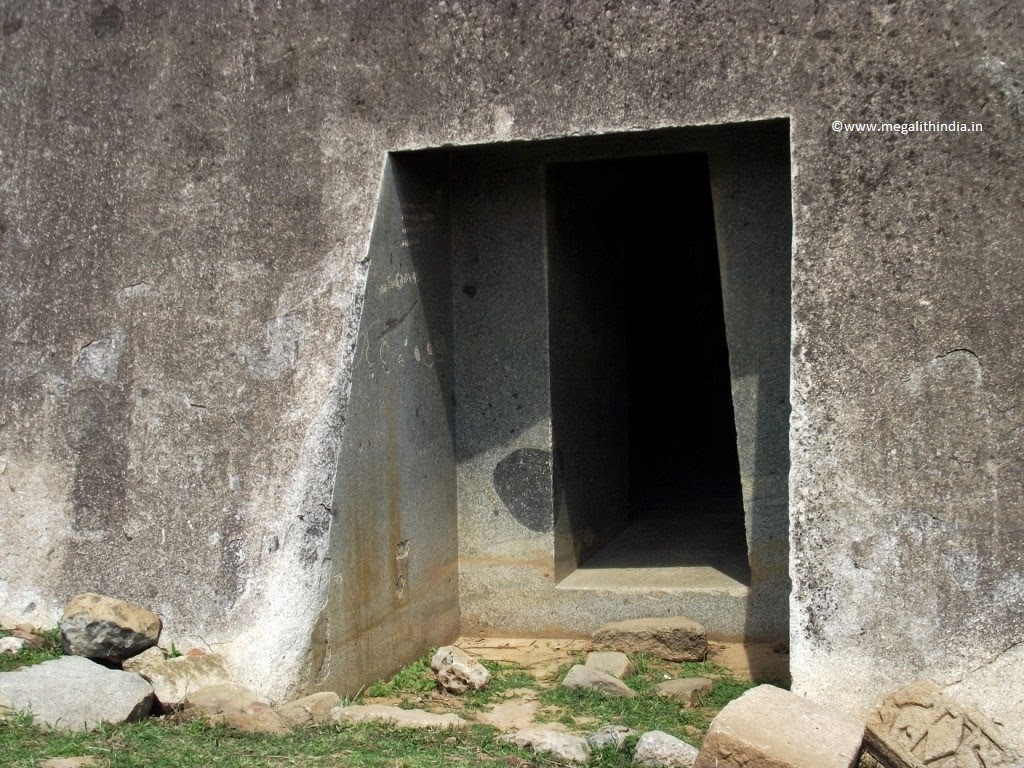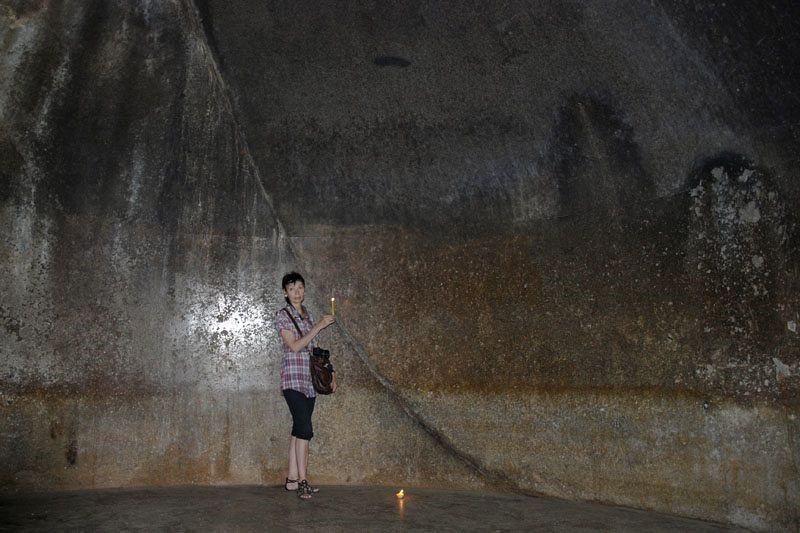Mysterious caves of Barabar for acoustic meditation.
About 40 km North-East from town of Gaya in the Indian state of Bihar, in the midst of an absolutely flat yellow-green plain, stands a small rocky ridge about three kilometers long. In the rocks of this ridge is a cave monastery Barabar - the oldest surviving in India. Four caves, carved(?) in the rock, belong to the reign of king Ashoka the Great, the first monarch to adopt Buddhism as the official religion.

The caves themselves – the gift of king Ashoka this sect, what says the inscription on one of the walls. The biggest mystery caves of Barabar are perfectly polished walls, a perfect semicircular shape.

In its Central part is the oldest in India man-made caves, a group of rocky hills called Barabar (Barabar(Banawar) Hill). About one and a half kilometres away to the East is another location of these caves, belonging to the historical period Barabara – rocky hill Nagarjuni (Nagarjuni Hill). Most often both of these places are referred to under one General name: "the caves of Barabar" (Barabar Caves).
A group of "Barabar" consists of four caves, and a group of "Nagarjuna" – three. The caves date back to the time of the great Mauryan Empire: they were constructed during the reign of Emperor Ashoka (268-232 BC) and his successor Dasaratha (232-225 BC). Along with two caves Sleep Bhandar (Son Bhandar Caves) in Rajgir they are the most ancient cave temples of India .
One of the most interesting features of these rock structures is that they were neither Buddhist nor Hindu, nor Jain, and belonged to a now defunct sect of philosophers shramana-ascetics Ajibekov. The caves of Barabar are the only construction associated with this lost philosophical or religious tradition - Ageliki
Photo 35.

(From the book by A. Basema "the Wonder that was India")
The third heterodox sect, which arose simultaneously with Buddhism and Jainism, were acewiki – a group of ascetics related, like the Jains, harsh discipline, and also renounced any clothes.
The teaching of the founder of the sect Gosale Mascarpone in many ways resembles the ideas of his contemporary Mahavira, one time a former friend of his. Like Mahavira, he was based on the teachings of the preceding verocity and ascetic sects, complementing and developing them. And Buddhist and Jain sources claim that he was a humble sort, he died about a year before Buddha, i.e. in 487 BC, after a fierce debate with Mahavira in Sravasti. His followers, apparently, has teamed up with students of other preachers such as the Antinomian Purana Kashyapa and atomist of Pakudha Katyayana, and formed a sect ajivika.
The heyday of the sect falls on the era of the Maurya – Asoka and his successor Dasaratha gave ajivika cave temples. Subsequently, however, the sect was quickly losing its influence, while maintaining a small number of followers, only in a small area East of Mysore and surrounding areas of Madras, where she was held until the fourteenth
century, after which it was already nothing more was heard.
Photo 3.

Ajivika texts did not reach us, and we know about them only from Buddhist and Jain polemics against the sect. Teaching Ajibekov was clearly atheistic and differed consistent with determinism. The traditional teachings on karma, as we know, argues that the human condition is determined by its past deeds, while the man himself can affect their destiny in the present and the future – with the help of proper behavior. Adivice denied it. They believed that there is an impersonal cosmic principle (niyati, i.e., fate), which defines everything in the world, down to the smallest detail. Therefore, to influence the process of transmigration is impossible.
Despite the fact that people can't have an impact on their future, the monks of the sect ajivika indulged in severe penances, explaining the destiny. However, the followers of rival creeds Ajibekov accused of promiscuity and immorality.
Photo 4.

Adivice the Dravidian South had developed their teachings in the direction close to the evolution of Buddhism "the great vehicle". Goshala they became the imperishable deity, like Buddha in the Mahayana system, and the doctrine of predestination was transformed into a doctrine resembling the views of Parmenides: the world is eternal and fixed, and every change and motion is an illusion. There is a certain similarity with the teachings on Nagarjuna's "emptiness"
Yet the amazing thing about the Caves of Barabar is not their unique antiquity, not belonging to long-extinct shramana mysterious sect, not a great accuracy of the geometry of space affects the quality and polishing of granite walls and arches, and the fact that these unusual structures were designed and built as acoustic cave rooms for meditation.
Photo 5.

The first three caves carved into a long rounded rock, stretched out from East to West for 200 metres and surprisingly similar in its shape to a giant submarine, the pop-up directly from the soil. Rock rocks – gneiss (metamorphic rock solid externally and its properties are very similar to granite, so I will always use the words "granite" and "granite").
Photo 6.

The path leads to the Northern side of the rock, where one cave - Chaupar Karan (Karan Chaupar). The cave is dated to 244 BC, as on the entrance doorway is the inscription, this cave was built 19 years after the ascension of Emperor Ashoka.
The cave is a simple rectangular entrance doorway, which immediately drew the attention of absolute geometry and the ideal treatment.
The cave is very peculiar, probably nothing of the sort among the religious buildings in the world: within a single picture, bas-relief, statues, etc.
Instead, a room with a perfectly designed geometric dimensions and the marvelous polishing (recall that all of this is carved in granite monolith in the 3rd century BC), with a fairly impressive dimensions: length: 10.4 m width: 4.3 m height: about 3.3. m (1.42 m wall and arch 1.84 m).
Photo 7.

Here's what travellers:
Then it was the most amazing thing: the overseer went to the side of the cave and yelled out a few words, after which the cave was filled with some artful sounds, many of them were obviously new, not connected with what was said the inspector.
Still a little stunned we began to experiment with sound, loudly pronouncing the phrase with different intonations and intervals or clapping their hands. Do not have time to finish the phrase, you immediately envelops the interweaving of a variety of sounds: some like a muted conversation, exclamations, the noise of the street, etc., others cause some acquaintances, but trudnoperevarivaema Association.
Very interesting and unexpected was the appearance of some not very intuitive and even strange feelings: standing in a pitch black cave (barely visible corners and walls), and it is palpably as if "flies" around you. Right psychedelic of some sort.
By the way all caves are indeed very dark. All lighting is fluorescent light through the front doorway and the candle, which was lit by the caretaker in the next cave. Photos were made with flash (the autofocus on your spouse with a candle) and then decently fine-tuned.
The result of our exercise was that the spouse still absolutely sure that the inside of the cave heard the noise of everyday village which is at the bottom: people's voices, cows mooing, children laughing, etc. and that "it" got inside either through the door or something. All my attempts to dissuade her with the help of physics and logic so far no to no avail – any arguments are powerless if the person really "is" heard.
Imagine in a dark cave with acoustics like this for hours, circling, breaking up into harmonic and interwoven again into something else, surround sound from repeated with a certain rhythm and intonation in different voices: "Om-m-m!" - just chill.
Photo 8.

When I meditated on the nature of this miracle, it is much regretted that he had not made some measurements of the attenuation on the stopwatch hours and tried to listen more closely to what disintegrate simple sounds (vowel, cotton, etc.). I can only say that the total sound attenuation occurs approximately within 5-6 seconds.
That all caves and Barbara Nagarjuna was created as a special acoustic halls, I have no doubt. Apparently the ancient builders knew how, what and where to build the premises for such an amazing reverb: all the caves are carved in the monolith; virtually identical in size and internal geometry; wall, roof and floor were polished with the highest quality. Even a perfectly rectangular openings all caves are the same – apparently there was some meaning (possibly served as resonator holes).
So there is no doubt that they were intended only for meditation or any ritual actions, and the ascetics lived somewhere nearby. From what modern scholars write, we can understand that ajivika very little is known (see above), and their ritual practices – nothing. So I guess we'll never know why the sect shramana ascetics and atheists need to create such "high tech", and most importantly insanely time-consuming "music box". sche two caves are on the opposite southern side of the rock. To get them you must climb to the crest of the cliff the stone stairs located near the entrance to the Karan Chopar, and descend on the opposite side.
Photo 9.

On the southern side of the rock the Western (first during) the cave, located almost symmetrically relative to the longitudinal axis of the rock with Karan Chaupar is called Sudama temple (Sudama).
The entrance to Sugamo is the same and is a simple rectangular aperture, as Karan Chaupar (by the way, here this way all the caves are locked). The internal layout is different from Sodomy Karan chaupar the cave consists of two rooms.
The first hall measuring 10 5.8 m and height of 3.6 m, the East wall of which is straightforward. The Western wall of this hall has the shape of a convex arc with a dome. The wall has such an unusual shape because follows the contour behind the second, a circular space with a diameter of 5.8 m. Polishing to Sudama probably the highest quality among all the caves Barbara (and may be better preserved), and the cave itself looks just perfect.
In a round room polishing the walls have survived worse – the natural corrosion, caused apparently seeping into cracks water. Here is added another reverb acoustic effect caused by the shape of the room: the voice of a man who stands in front of you is not heard "directly", instead it sounds loud then the right, then left ear (if occasionally a bit displaced). Cave under the rock inscription at the entrance dates from the 12th year of the reign of Ashoka (261 BC). Right (East) from Sodomy is the famous cave of Lomas Rishi (Lomas Rishi). "Famous" because the only cave Barbara has carved entrance portal, whose photo is the "business card" caves Barbara (two pictures of Barbara is sure to be one with the portal Lomas Rishi).
Photo 10.

Most likely the portal was not created by ajivika and most likely has ronnebygatan origin: the procession of elephants moving to the stupa in the center of the arc and the arch in the form of a sheet of pipala (pipile see here).
Lomas Rishi and the Sudama temple, consists of two rooms (rectangular and circular), but its construction for whatever reason have not been completed, therefore, on the plan of the second room looks like is not round, but oval – its just not finished.
S. P. Gupta And S. Vijayakumar. Temples in India Even inconclusive judging by the sizes (length – 10-11.1 m, width 5.2 m, diameter of round the room – 5.2 m), it is possible to judge that the Lomas Rishi was conceived as a copy Sodomy.
The time and the reason that works in the cave were not completed is unknown.
Inside the well we can see what method was the cutting out in the cliff areas and it is quite obvious that it was done with a certain technology and high-quality steel tool (I'm writing that modern scholars are still not clear on many aspects of equipment processing stone and iron in ancient India).
In India and in subsequent years was not looking for easy ways. Amazes the number of cave churches, carved entirely in solid rock and decorated with a huge number of columns, sculptures and reliefs, among them many samples with the same famous finish. In China and South-East Asia it was not so: there is usually worked with Sandstone, limestone, shales, clayey rocks and similar hardness materials.
Photo 11.

Фото 12.

Фото 13.

Фото 14.

Фото 15.

Фото 16.

Granite rocks are covered with moss and walk on them even in dry weather it is necessary cautiously. In rain and fog, they are just very slippery, and stay on the sloping wet surface is almost impossible downhill guaranteed. We estimated such paths-dashed lines when in the rain bypassed the cave complex near Mumbai Kanheri – without them, getting around the rocks would be simply impossible.
Visvarupa (Visva Zopri, Visvajhopri) – fourth cave from the group Barabar – is located about half a kilometer from the first cave – Karan Chaupar.
In itself it is not much interest, because it is not just unfinished, but rather "slightly started". A much more interesting way to the cave over rocks and downhill on "Ashoka-steps" right into the village. Pictured below: the "back" of the rock in which carved Visvarupa.
In recent decades, for some unknown reason the cracks in the rock have been very actively progressing, reached the caves and water began to erode its vault. Several years ago the cracks were patched with mortar and filled with bitumen (it seems not very high quality). Before that was built the defensive wall in the rainy season is not eroded area in front of the cave
Photo 17.

Фото 18.

Фото 19.

Фото 20.

Фото 21.

Фото 22.

Фото 23.

Фото 24.

Фото 25.

Фото 26.

Фото 27.

Photo 28. Exactly the same "stairs" are available in Sri Lanka, Sigiriya the Lion mountain. →. "How to soften stone."

"Ashoka steps" – the track leading from the caves to the village paths dashes of rectangular notches cut on the surface of rocks in the same times (3 century BC), and the caves themselves.
Photo 29.

Фото 30.

Фото 31.

Фото 32.

Фото 33.

Фото 34.

Фото 36.

Фото 37.

Фото 38.

Фото 39.

Фото 40.

Фото 41.

Фото 42.

Фото 43.

Фото 44.

Источник: https://masterok.livejournal.com/1940184.html
Autor: masterok

















































